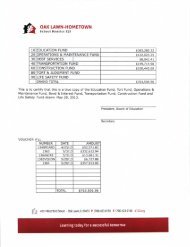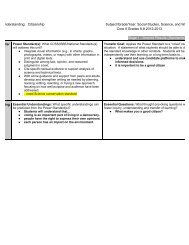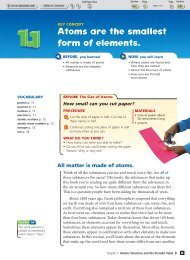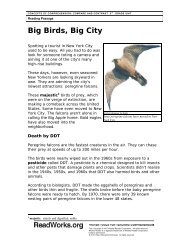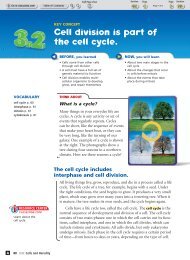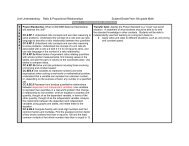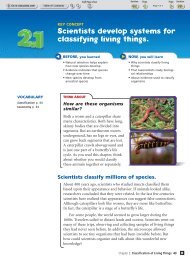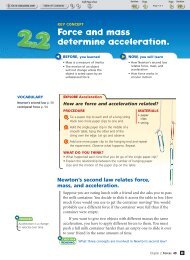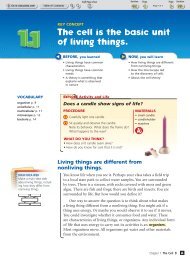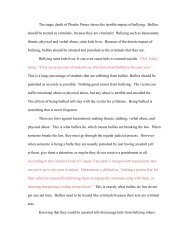Work is the use of force to move an object.
Work is the use of force to move an object.
Work is the use of force to move an object.
Create successful ePaper yourself
Turn your PDF publications into a flip-book with our unique Google optimized e-Paper software.
KEY CONCEPT<br />
<strong>Work</strong> <strong>is</strong> <strong>the</strong> <strong>use</strong> <strong>of</strong> <strong>force</strong><br />
<strong>to</strong> <strong>move</strong> <strong>an</strong> <strong>object</strong>.<br />
BEFORE, you learned<br />
• An unbal<strong>an</strong>ced <strong>force</strong> produces<br />
acceleration<br />
•Weight <strong>is</strong> measured in new<strong>to</strong>ns<br />
NOW, you will learn<br />
• How <strong>force</strong> <strong>an</strong>d work are related<br />
• How moving <strong>object</strong>s do work<br />
VOCABULARY<br />
work p. 115<br />
joule p. 117<br />
EXPLORE <strong>Work</strong><br />
How do you work?<br />
PROCEDURE<br />
1<br />
2<br />
Lift a book from <strong>the</strong> floor <strong>to</strong> your desk<strong>to</strong>p.<br />
Try <strong>to</strong> <strong>move</strong> <strong>the</strong> book at a const<strong>an</strong>t speed.<br />
Now lift <strong>the</strong> book again, but s<strong>to</strong>p about<br />
halfway up <strong>an</strong>d hold <strong>the</strong> book still for<br />
about 30 seconds. Then continue lifting<br />
<strong>the</strong> book <strong>to</strong> <strong>the</strong> desk<strong>to</strong>p.<br />
WHAT DO YOU THINK?<br />
• Do you think you did more work<br />
<strong>the</strong> first time you lifted <strong>the</strong> book<br />
or <strong>the</strong> second time you lifted <strong>the</strong> book?<br />
• What do you think work me<strong>an</strong>s?<br />
MATERIALS<br />
book<br />
VOCABULARY<br />
You might w<strong>an</strong>t <strong>to</strong> make a<br />
description wheel diagram<br />
in your notebook for work.<br />
Force <strong>is</strong> necessary <strong>to</strong> do work.<br />
What comes <strong>to</strong> mind when you think <strong>of</strong> work? Most people say <strong>the</strong>y<br />
are working when <strong>the</strong>y do <strong>an</strong>ything that requires a physical or mental<br />
effort. But in physical science, work <strong>is</strong> <strong>the</strong> <strong>use</strong> <strong>of</strong> <strong>force</strong> <strong>to</strong> <strong>move</strong> <strong>an</strong><br />
<strong>object</strong> some d<strong>is</strong>t<strong>an</strong>ce. In scientific terms, you do work only when you<br />
exert a <strong>force</strong> on <strong>an</strong> <strong>object</strong> <strong>an</strong>d <strong>move</strong> it. According <strong>to</strong> th<strong>is</strong> definition<br />
<strong>of</strong> work, reading th<strong>is</strong> page <strong>is</strong> not doing work. Turning <strong>the</strong> page,<br />
however, would be work beca<strong>use</strong> you are lifting <strong>the</strong> page.<br />
Solving a math problem in your head <strong>is</strong> not doing work. Writing<br />
<strong>the</strong> <strong>an</strong>swer <strong>is</strong> work beca<strong>use</strong> you are moving <strong>the</strong> pencil across <strong>the</strong> paper.<br />
If you w<strong>an</strong>t <strong>to</strong> do work, you have <strong>to</strong> <strong>use</strong> <strong>force</strong> <strong>to</strong> <strong>move</strong> something.<br />
check your reading<br />
How does <strong>the</strong> scientific definition <strong>of</strong> work differ from <strong>the</strong><br />
familiar definition?<br />
Chapter 4: <strong>Work</strong> <strong>an</strong>d Energy 115<br />
CD
RESOURCE CENTER<br />
CLASSZONE.COM<br />
Learn more about work.<br />
Force, Motion, <strong>an</strong>d <strong>Work</strong><br />
<strong>Work</strong> <strong>is</strong> done only when <strong>an</strong> <strong>object</strong> that <strong>is</strong> being pushed or pulled actually<br />
<strong>move</strong>s. If you lift a book, you exert a <strong>force</strong> <strong>an</strong>d do work. What if you<br />
simply hold <strong>the</strong> book out in front <strong>of</strong> you? No matter how tired your<br />
muscles may become from holding <strong>the</strong> book still, you are not doing<br />
work unless you <strong>move</strong> <strong>the</strong> book.<br />
The work done by a <strong>force</strong> <strong>is</strong> related <strong>to</strong> <strong>the</strong> size <strong>of</strong> <strong>the</strong> <strong>force</strong> <strong>an</strong>d <strong>the</strong><br />
d<strong>is</strong>t<strong>an</strong>ce over which <strong>the</strong> <strong>force</strong> <strong>is</strong> applied. How much work does it take<br />
<strong>to</strong> push a grocery cart down <strong>an</strong> a<strong>is</strong>le? The <strong>an</strong>swer depends on how<br />
hard you push <strong>the</strong> cart <strong>an</strong>d <strong>the</strong> length <strong>of</strong> <strong>the</strong> a<strong>is</strong>le. If you <strong>use</strong> <strong>the</strong> same<br />
amount <strong>of</strong> <strong>force</strong>, you do more work pushing a cart down a long a<strong>is</strong>le<br />
th<strong>an</strong> a short a<strong>is</strong>le.<br />
<strong>Work</strong> <strong>is</strong> done only by <strong>the</strong> part <strong>of</strong> <strong>the</strong> applied <strong>force</strong> that acts in <strong>the</strong><br />
same direction as <strong>the</strong> motion <strong>of</strong> <strong>an</strong> <strong>object</strong>. Suppose you need <strong>to</strong> pull a<br />
heavy suitcase on wheels. You pull <strong>the</strong> h<strong>an</strong>dle up at <strong>an</strong> <strong>an</strong>gle as you pull<br />
<strong>the</strong> suitcase forward. Only <strong>the</strong> part <strong>of</strong> <strong>the</strong> <strong>force</strong> pulling <strong>the</strong> suitcase forward<br />
<strong>is</strong> doing work. The <strong>force</strong> with which you pull upward on <strong>the</strong><br />
h<strong>an</strong>dle <strong>is</strong> not doing work beca<strong>use</strong> <strong>the</strong> suitcase <strong>is</strong> not moving upward—<br />
unless you are going uphill.<br />
check your reading<br />
Give two examples <strong>of</strong> when you are applying a <strong>force</strong> but not<br />
doing work.<br />
<strong>Work</strong><br />
<strong>Work</strong> <strong>is</strong> done by <strong>force</strong> that acts in <strong>the</strong> same direction<br />
as <strong>the</strong> motion <strong>of</strong> <strong>an</strong> <strong>object</strong>.<br />
All <strong>of</strong> <strong>the</strong> Applied Force Does <strong>Work</strong><br />
Part <strong>of</strong> <strong>the</strong> Applied Force Does <strong>Work</strong><br />
applied <strong>force</strong><br />
part <strong>of</strong> <strong>force</strong><br />
doing work<br />
part <strong>of</strong> <strong>force</strong><br />
not doing work<br />
applied <strong>force</strong><br />
direction <strong>of</strong> motion<br />
direction <strong>of</strong> motion<br />
How does ch<strong>an</strong>ging <strong>the</strong> direction <strong>of</strong> <strong>the</strong> applied <strong>force</strong><br />
ch<strong>an</strong>ge <strong>the</strong> amount <strong>of</strong> <strong>the</strong> <strong>force</strong> that <strong>is</strong> doing work?<br />
CD 116 Unit: Motion <strong>an</strong>d Forces
Calculating <strong>Work</strong><br />
<strong>Work</strong> <strong>is</strong> a measure <strong>of</strong> how much <strong>force</strong> <strong>is</strong> applied<br />
over a certain d<strong>is</strong>t<strong>an</strong>ce. You c<strong>an</strong> calculate <strong>the</strong> work<br />
a <strong>force</strong> does if you know <strong>the</strong> size <strong>of</strong> <strong>the</strong> <strong>force</strong> applied<br />
<strong>to</strong> <strong>an</strong> <strong>object</strong> <strong>an</strong>d <strong>the</strong> d<strong>is</strong>t<strong>an</strong>ce over which <strong>the</strong> <strong>force</strong><br />
acts. The d<strong>is</strong>t<strong>an</strong>ce involved <strong>is</strong> <strong>the</strong> d<strong>is</strong>t<strong>an</strong>ce <strong>the</strong> <strong>object</strong><br />
<strong>move</strong>d in <strong>the</strong> direction <strong>of</strong> that <strong>force</strong>. The calculation<br />
for work <strong>is</strong> shown in <strong>the</strong> following formula:<br />
<strong>Work</strong> = Force · d<strong>is</strong>t<strong>an</strong>ce<br />
W = Fd<br />
You read in previous chapters that you c<strong>an</strong><br />
measure <strong>force</strong> in new<strong>to</strong>ns. You also know that you<br />
c<strong>an</strong> measure d<strong>is</strong>t<strong>an</strong>ce in meters. When you multiply a <strong>force</strong> in new<strong>to</strong>ns<br />
times a d<strong>is</strong>t<strong>an</strong>ce in meters, <strong>the</strong> product <strong>is</strong> a measurement called<br />
<strong>the</strong> new<strong>to</strong>n-meter (Npm), or <strong>the</strong> joule (jool).<br />
The joule (J) <strong>is</strong> <strong>the</strong> st<strong>an</strong>dard unit <strong>use</strong>d <strong>to</strong> measure work. One joule<br />
<strong>of</strong> work <strong>is</strong> done when a <strong>force</strong> <strong>of</strong> one new<strong>to</strong>n <strong>move</strong>s <strong>an</strong> <strong>object</strong> one<br />
meter. To get <strong>an</strong> idea <strong>of</strong> how much a joule <strong>of</strong> work <strong>is</strong>, lift <strong>an</strong> apple<br />
(which weighs about one new<strong>to</strong>n) from your foot <strong>to</strong> your wa<strong>is</strong>t<br />
(about one meter).<br />
Use <strong>the</strong> formula for work <strong>to</strong> solve <strong>the</strong> problem below.<br />
Th<strong>is</strong> m<strong>an</strong> <strong>is</strong> doing work<br />
when he applies <strong>force</strong> <strong>to</strong><br />
lift h<strong>is</strong> body.<br />
Calculating <strong>Work</strong><br />
Sample Problem<br />
How much work <strong>is</strong> done if a person lifts a barbell weighing 450 N <strong>to</strong><br />
a height <strong>of</strong> 2 m?<br />
What do you know?<br />
What do you w<strong>an</strong>t <strong>to</strong> find out?<br />
Write <strong>the</strong> formula:<br />
Substitute in<strong>to</strong> <strong>the</strong> formula:<br />
Calculate <strong>an</strong>d simplify:<br />
Check that your units agree:<br />
<strong>force</strong> needed <strong>to</strong> lift = 450 N, d<strong>is</strong>t<strong>an</strong>ce = 2 m<br />
<strong>Work</strong><br />
W = Fd<br />
W = 450 N p 2 m<br />
W = 900 Npm<br />
Unit <strong>is</strong> new<strong>to</strong>n-meter (Npm).<br />
Unit <strong>of</strong> work <strong>is</strong> joule, which <strong>is</strong> Npm.<br />
Units agree.<br />
Practice <strong>the</strong> Math<br />
Answer:<br />
W = 900 J<br />
1. If you push a cart with a <strong>force</strong> <strong>of</strong> 70 N for 2 m, how much work <strong>is</strong> done?<br />
2. If you did 200 J <strong>of</strong> work pushing a box with a <strong>force</strong> <strong>of</strong> 40 N, how far did<br />
you push <strong>the</strong> box?<br />
reminder<br />
You know that W = Fd.<br />
You c<strong>an</strong> m<strong>an</strong>ipulate <strong>the</strong><br />
formula <strong>to</strong> find <strong>force</strong> or<br />
d<strong>is</strong>t<strong>an</strong>ce.<br />
d = W F <strong>an</strong>d F = W d <br />
Chapter 4: <strong>Work</strong> <strong>an</strong>d Energy 117<br />
CD
MAIN IDEA WEB<br />
Remember <strong>to</strong> org<strong>an</strong>ize your<br />
notes in a web as you read.<br />
Objects that are moving c<strong>an</strong> do work.<br />
You do work when you pick up your books, hit a baseball, swim a lap,<br />
or tap a keyboard. These examples show that you do work on <strong>object</strong>s,<br />
but <strong>object</strong>s c<strong>an</strong> also do work.<br />
For example, in a bowling alley, <strong>the</strong> bowling balls do work on <strong>the</strong><br />
pins <strong>the</strong>y hit. Outdoors, <strong>the</strong> moving air particles in a gust <strong>of</strong> wind do<br />
work that lifts a leaf <strong>of</strong>f <strong>the</strong> ground. Moving water, such as <strong>the</strong> water<br />
in a river, also does work. If <strong>the</strong> windblown leaf l<strong>an</strong>ds in <strong>the</strong> water, it<br />
might be carried downstream by <strong>the</strong> current. As <strong>the</strong> leaf travels downstream,<br />
it might go over <strong>the</strong> edge <strong>of</strong> a waterfall. In that case, <strong>the</strong><br />
gravitational <strong>force</strong> <strong>of</strong> Earth would pull <strong>the</strong> leaf <strong>an</strong>d water down.<br />
You c<strong>an</strong> say that <strong>an</strong> <strong>object</strong> or person does work on <strong>an</strong> <strong>object</strong>, or<br />
that <strong>the</strong> <strong>force</strong> <strong>the</strong> <strong>object</strong> or person <strong>is</strong> exerting does work. For example,<br />
you could say that Earth (<strong>an</strong> <strong>object</strong>) does work on <strong>the</strong> falling water, or<br />
that gravity (a <strong>force</strong>) does work on <strong>the</strong> water.<br />
<strong>Work</strong><br />
How much work does it take?<br />
PROCEDURE<br />
1<br />
2<br />
3<br />
Have a partner help you measure how high your shoulders are from<br />
<strong>the</strong> ground. Record <strong>the</strong> d<strong>is</strong>t<strong>an</strong>ce in meters. Round <strong>to</strong> <strong>the</strong> nearest tenth<br />
<strong>of</strong> a meter.<br />
Attach <strong>the</strong> notebook <strong>to</strong> <strong>the</strong> spring scale. Then slowly lift <strong>the</strong> notebook<br />
<strong>to</strong> your shoulder <strong>to</strong> see how much <strong>force</strong> you are exerting. Record <strong>the</strong><br />
amount in new<strong>to</strong>ns.<br />
Calculate <strong>the</strong> work you did while lifting one notebook. Use th<strong>is</strong> information <strong>to</strong><br />
estimate how much work you do every day when you pick up all your<br />
notebooks <strong>to</strong> take <strong>the</strong>m <strong>to</strong> school. (Hint: <strong>Work</strong> equals <strong>force</strong> times d<strong>is</strong>t<strong>an</strong>ce.)<br />
SKILL FOCUS<br />
Measuring<br />
MATERIALS<br />
• meter stick<br />
•spiral notebook<br />
•spring scale<br />
TIME<br />
20 minutes<br />
WHAT DO YOU THINK?<br />
•Approximately how much work does it take <strong>to</strong> pick up<br />
your notebook?<br />
• How would <strong>the</strong> amount <strong>of</strong> work you do ch<strong>an</strong>ge if you<br />
were shorter? taller?<br />
• How much work are you doing on <strong>the</strong> notebook if you<br />
have s<strong>to</strong>pped <strong>to</strong> talk <strong>to</strong> a friend?<br />
CHALLENGE If you pick up a notebook 10 times a day during<br />
<strong>the</strong> school year, how much work do you do on <strong>the</strong> notebook in one<br />
year? (Assume that <strong>the</strong>re are 180 school days in a year.)<br />
CD 118 Unit: Motion <strong>an</strong>d Forces
APPLY How could you<br />
increase <strong>the</strong> work done<br />
by th<strong>is</strong> water wheel?<br />
Throughout h<strong>is</strong><strong>to</strong>ry, people have taken adv<strong>an</strong>tage <strong>of</strong> <strong>the</strong> capability <strong>of</strong><br />
<strong>object</strong>s in motion <strong>to</strong> do work. M<strong>an</strong>y early cultures built machines such<br />
as water wheels <strong>to</strong> <strong>use</strong> <strong>the</strong> <strong>force</strong> exerted by falling water, <strong>an</strong>d windmills <strong>to</strong><br />
<strong>use</strong> <strong>the</strong> <strong>force</strong> exerted by moving air. In a water wheel like <strong>the</strong> one in <strong>the</strong><br />
pho<strong>to</strong>graph, gravity does work on <strong>the</strong> water. As <strong>the</strong> water falls, it also c<strong>an</strong><br />
do work on <strong>an</strong>y <strong>object</strong> that <strong>is</strong> put in its path. Falling water c<strong>an</strong> turn a<br />
water wheel or <strong>the</strong> turbine <strong>of</strong> <strong>an</strong> electric genera<strong>to</strong>r.<br />
The water wheel shown above <strong>use</strong>s <strong>the</strong> work done by water <strong>to</strong><br />
turn gears that run a mill <strong>an</strong>d grind grain. In <strong>the</strong> same way, windmills<br />
take adv<strong>an</strong>tage <strong>of</strong> <strong>the</strong> <strong>force</strong> <strong>of</strong> moving air particles. The wind ca<strong>use</strong>s<br />
<strong>the</strong> sails <strong>of</strong> a windmill <strong>to</strong> turn. The turning sails do work <strong>to</strong> run<br />
machinery or <strong>an</strong> irrigation system.<br />
check your reading<br />
Describe how a water wheel does work.<br />
KEY CONCEPTS<br />
1. If you push very hard on <strong>an</strong><br />
<strong>object</strong> but it does not <strong>move</strong>,<br />
have you done work? Explain.<br />
2. What two fac<strong>to</strong>rs do you<br />
need <strong>to</strong> know <strong>to</strong> calculate<br />
how much work was done in<br />
<strong>an</strong>y situation?<br />
3. Was work done on a book that<br />
fell from a desk <strong>to</strong> <strong>the</strong> floor? If<br />
so, what <strong>force</strong> was involved?<br />
CRITICAL THINKING<br />
4. Syn<strong>the</strong>size <strong>Work</strong> <strong>is</strong> done on<br />
a ball when a soccer player<br />
kicks it. Is <strong>the</strong> player still doing<br />
work on <strong>the</strong> ball as it rolls<br />
across <strong>the</strong> ground? Explain.<br />
5. Calculate Tina lifted a box<br />
0.5 m. The box weighed 25 N.<br />
How much work did Tina do<br />
on <strong>the</strong> box?<br />
CHALLENGE<br />
6. Analyze Ben <strong>an</strong>d Andy each<br />
pushed <strong>an</strong> empty grocery cart.<br />
Ben <strong>use</strong>d twice <strong>the</strong> <strong>force</strong>, but<br />
<strong>the</strong>y both did <strong>the</strong> same<br />
amount <strong>of</strong> work. Explain.<br />
Chapter 4: <strong>Work</strong> <strong>an</strong>d Energy 119<br />
CD



